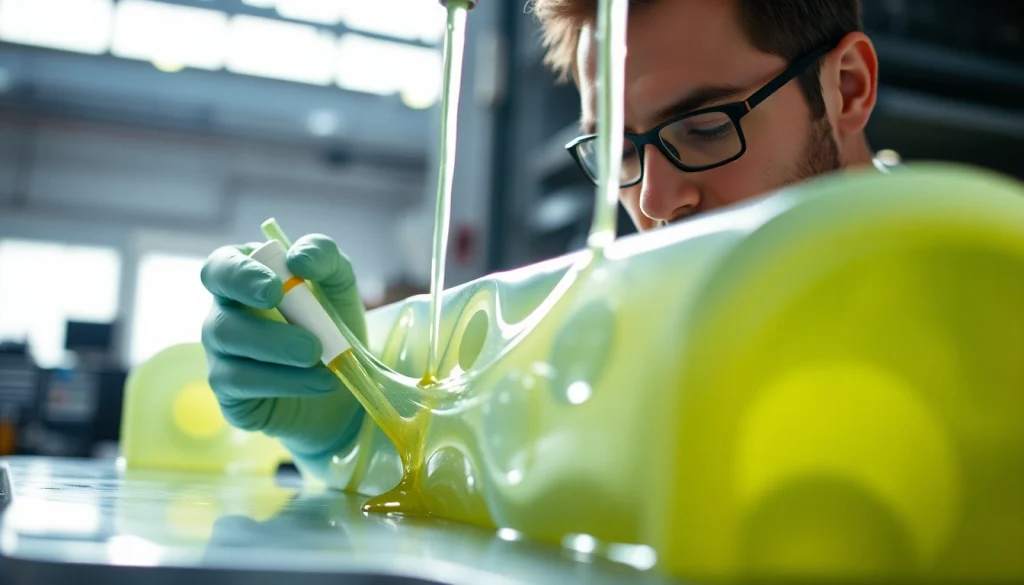Maximizing Performance with Infusion Resins in Composite Fabrication

Understanding Infusion Resins
What are Infusion Resins?
Infusion resins are specialized materials used in the manufacturing of composite structures, primarily through infusion techniques such as vacuum infusion. These resins are a critical component in the composite manufacturing process, allowing for the production of lightweight and high-strength materials. They are characterized by their low viscosity, which allows them to flow easily into fiber reinforcement materials, ensuring a complete saturation and bond within the composite structure. The use of infusion resins enables manufacturers to create precise and consistent composite parts that are essential in industries ranging from aerospace to automotive.
Benefits of Using Infusion Resins
Infusion resins provide substantial benefits in the composite fabrication process, making them a preferred choice among manufacturers. Notable advantages include:
- Enhanced Mechanical Properties: Infusion resins contribute to the mechanical strength and durability of the composite structures.
- Low Viscosity: Their low viscosity allows for better flow characteristics, enabling thorough impregnation of the reinforcement fibers.
- Reduced Volatiles: Many infusion resins produce fewer volatile organic compounds (VOCs) compared to traditional resins, making the process more environmentally friendly.
- Sustainability: Increasingly, bio-based infusion resins are available, contributing to more sustainable manufacturing practices.
- Improved Surface Finish: The vacuum infusion process can yield smoother surfaces, reducing the need for extensive post-processing.
Common Applications in Composite Manufacturing
Infusion resins are widely utilized across various industries due to their versatility and performance. Common applications include:
- Aerospace: In the aerospace sector, infusion resins are used for components that must meet high strength-to-weight ratios while maintaining structural integrity.
- Marine: These resins are used in manufacturing boat hulls and components, offering excellent resistance to corrosion and moisture.
- Automotive: Infusion resins are applied in the production of lightweight parts that can help improve fuel efficiency.
- Wind Energy: The renewable energy sector uses infusion resins for manufacturing energy-efficient wind turbine blades that are robust yet lightweight.
- Consumer Goods: Innovative products, including sports equipment and electronic housings, are increasingly made using infusion resins.
Types of Infusion Resins
Epoxy Infusion Resins
Epoxy infusion resins are among the most popular types due to their superior adhesion and chemical resistance. They offer excellent performance in a range of conditions, making them suitable for various applications. Epoxy resins can be engineered for specific properties, such as flexibility, temperature resistance, or high mechanical strength, depending on the end-use requirements.
Polyester and Vinylester Resins
Polyester and vinylester resins provide a cost-effective alternative to epoxy resins, commonly used in applications where high chemical resistance is not the primary concern. While generally offering lower mechanical properties than epoxy, these resins are beneficial for projects with budget constraints. Their ease of use and faster curing times appeal to many manufacturers.
Bio-based Infusion Resins
As sustainability becomes increasingly important, bio-based infusion resins have emerged as a viable alternative. These resins are formulated from renewable resources, reducing the reliance on petroleum-based materials. Innovations in this segment ensure that bio-based resins maintain performance standards comparable to traditional resins while catering to sustainability goals.
Choosing the Right Infusion Resins
Factors to Consider: Temperature, Viscosity, and Curing Time
When selecting infusion resins, several key factors must be considered:
- Temperature: The service temperature range of the application should dictate the resin choice. Higher temperatures generally require more specialized resins with superior thermal properties.
- Viscosity: The viscosity of a resin affects its ability to saturate fiber reinforcements. Low viscosity resins are preferred for complex molds or intricate designs.
- Curing Time: Different applications may necessitate varying pot life or curing times. Manufacturers should align viscosity and curing characteristics with their project timelines.
Matching Resins to Specific Applications
Not all infusion resins are suitable for every application. For instance, aerospace components often require the use of epoxy resins due to their high mechanical properties, while marine applications may efficiently employ a polyester resin that balances cost and performance. Understanding the specific demands of each application helps ensure optimal performance and longevity of the final product.
Technical Specifications and Performance Metrics
When evaluating infusion resins, manufacturers should also consider technical specifications such as tensile strength, elongation at break, flexural modulus, and thermal stability. These metrics provide insights into how a resin will perform under operational conditions. Additionally, understanding the compatibility of the resin with reinforcement materials, such as carbon fiber or fiberglass, is vital for achieving desired outcomes.
Best Practices for Infusion Resin Application
Surface Preparation and Mold Design
Proper surface preparation is critical in the infusion process. The mold surface must be clean and free of contaminants that may affect adhesive properties. Additionally, the design of the mold should facilitate the easy flow of resin, reducing potential air pockets. Employing techniques such as incorporating venting ports and optimizing resin flow paths enhances the quality and consistency of the infused part.
Mixing and Handling Techniques
The mixing and handling of infusion resins require precise execution to ensure consistent performance. Follow manufacturer guidelines for mixing ratios and techniques to prevent viscosity inconsistencies. During handling, it’s crucial to avoid introducing air into the resin mix, which can lead to defects in the composite structure.
Common Mistakes to Avoid
Manufacturers should be aware of common pitfalls in resin infusion applications:
- Inadequate Surface Preparation: Neglecting to prepare the surface can lead to poor adhesion or delamination of layers.
- Improper Resin Ratio: Using incorrect resin-to-hardener ratios can affect curing times and result in weak or brittle parts.
- Inconsistent Mixing: Failing to achieve a homogeneous mix can lead to variations in resin properties and performance.
Innovations in Infusion Resins
Recent Advances in Resin Technology
Recent developments in resin technology have introduced performance-enhancing additives and eco-friendly formulations. These innovations aim to improve processing efficiency and provide enhanced properties without compromising the performance of composites. For instance, advancements in low-temperature curing resins allow for greater flexibility in manufacturing schedules.
Future Trends in Composite Manufacturing
The future of composite manufacturing is likely to be influenced by further developments in infusion resin technology. Ongoing research in bio-based resins, as well as the integration of smart materials, will potentially revolutionize the landscape. This could include the advent of multifunctional resins that provide structural integrity while offering additional features such as self-healing capabilities or improved thermal management.
Case Studies of Successful Applications
Real-world applications illustrate the effectiveness of infusion resins in enhancing performance and operational efficiency. For example, the successful implementation of bio-based infusion resins in wind turbine blade production not only reduced weight but also upheld stringent strength and durability standards. Such examples underscore the significant potential infusion resins hold in various industries, driving innovation and sustainable practices.







